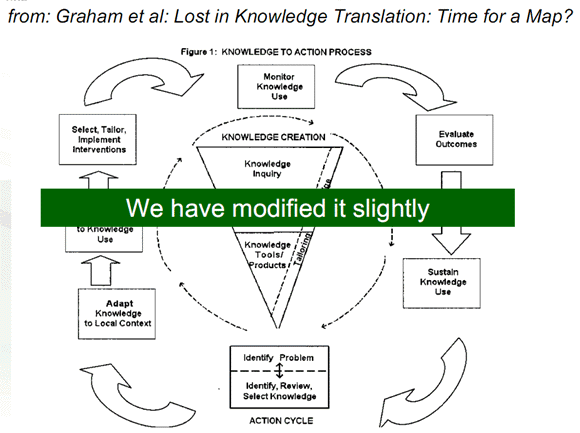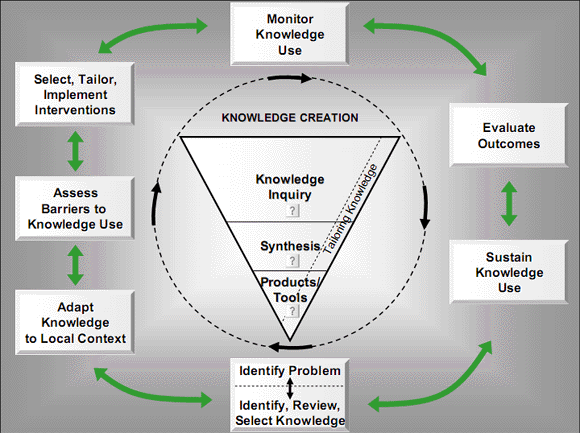Section 5.1 Knowledge dissemination and exchange of knowledge
Michelle Gagnon
The Knowledge to Action Cycle
Chapter Overview
IntroductionKnowledge Dissemination
- What is knowledge dissemination?
- Fundamentals of knowledge dissemination
What is Knowledge Exchange?
What Makes the Integrated KT Process Work Effectively?
Future Research
Summary
Introduction: Knowledge dissemination and exchange
- Can take place at the end of a project once findings are ready to share (i.e. end of grant KT) or throughout the research process, if appropriate (i.e. integrated KT-IKT)
- Traditional end of grant KT typically involves publication in peer-reviewed journals or presentation of results at appropriate meetings
- Where appropriate dissemination can also include more non-traditional activities such as face to face meetings with knowledge users or engagement with media
- Depending on the intent of the research endeavour, dissemination and exchange may be woven into the research process through an interactive, IKT process
- Applicants are often asked to consider their knowledge dissemination strategy, which may also include knowledge exchange, when preparing grant applications
What is knowledge dissemination?
Diffusion ("just let it happen")
- passive, unplanned, uncontrolled dissemination; primarily horizontal or mediated by peers (e.g. publishing in peer reviewed journals, presenting research results to peers at academic conferences); potential user needs to seek out the information
Dissemination ("make it happen")
- active process to communicate results to potential users by targeting, tailoring and packaging the message for a particular target audience; strategies include: linkage and exchange events to share relevant research syntheses; developing a user driven dissemination strategy; media engagement; using a knowledge broker; developing researcher/knowledge user networks
Fundamentals of dissemination (derived from literature review for this chapter)
- Dissemination processes and approaches should be informed by high-quality context specific evidence (e.g. systematic reviews that examine the effectiveness and efficiency of dissemination strategies targeted at health professionals; systematic reviews of studies that focus ion factors that influence evidence use in policy making)
- Messages should be clear, simple, action-oriented and tailored for each audience (i.e. knowledge user driven)
- Dissemination strategies should include a plan to evaluate the impact of the chosen approach, including ways to measure success
- Consider – What is the message? Who is the audience? Who is the messenger? What is the best dissemination method? What is the expected outcome?
Examples of approaches to knowledge dissemination
Knowledge brokers
- Serve as an intermediary who can facilitate collaborations between researchers and knowledge users, find evidence to shape decisions, assess, interpret and adapt evidence to local context and identify emerging issues that research can help solve
- Marketing and communication knowledge and skills and the capacity to span boundaries and understand the potentially disparate worlds of researchers and knowledge users is recommended
- Individuals with diverse experience in these different worlds or organizations whose mandate it is to span these worlds would be ideal knowledge brokers
- Knowledge brokering is not new; what is new are calls to recognize and formalize this role and evaluate its effectiveness as a KT mechanism
Networks
- Connect researchers and knowledge users who might not otherwise have an opportunity to interact, enable dialogue, stimulate learning and capture and disseminate knowledge
- A few examples of networks include:
Another taxonomy for KT activities
Push, pull and exchange are concepts that are relevant to dissemination and exchange and provide another way to categorize and understand the KT process- Push:
- producers of knowledge plan and implement approaches to push (disseminate) knowledge toward audiences who they believe need to receive it
- Pull:
- knowledge users plan and implement strategies to pull knowledge from sources they identify as producing knowledge that is useful to their decision making
- Exchange:
- includes efforts to bring the researcher and knowledge user communities together through an interactive process either at the end of a project to facilitate end of grant KT or throughout the research project as part of an IKT approach
What is knowledge exchange?
- Integrated knowledge translation also known as collaborative research, action research, participatory research, co-production of knowledge or Mode 2 research
- Involves researcher/knowledge user collaboration throughout the research process
- This approach is most appropriately used to understand and address complex, relevant and timely "real-life health or health system issues that require engagement of multiple stakeholders in both the research and change processes
- Potentially more time-consuming, demanding and resource intensive but involving knowledge users as partners in the research process is a strong predictor that the research findings will be used the research project will achieve a greater impact
What makes the integrated KT (IKT) process work effectively?
Key IKT success factors derived from the literature review for this chapter include:
- A process to develop a shared perspective, common language and common understanding about the health problem/issue that the team will focus on
- A mutually negotiated and agreed upon plan to guide the collaboration including clear roles and responsibilities
- Including team members with experience in engaging in collaborative research processes
- A strategy for ensuring that trusting relationships among team members are maintained and conflicts are resolved appropriately when they arise
- Institutional support, including incentives in both academic and knowledge user environments to participate in and recognize IKT as a worthwhile activity
Future Research
- Studies are needed to help identify and test optimal strategies for knowledge dissemination and exchange in different contexts
- In particular, studies are needed to evaluate the impact of knowledge brokers and networks as KT mechanisms
- As innovative approaches to exchange and dissemination grow and evolve, increasing focus should be placed on developing indicators to evaluate these processes and their impact on relevant short, medium and long-term outcomes
Key learning points:
- Dissemination targets research findings to specific audiences
- Dissemination activities should be considered and outlined in a dissemination plan
- Researchers should engage knowledge users to craft messages and help disseminate research findings
- Collaborative relationships between researchers and knowledge users built on trust and frequent interaction appear to enhance the effectiveness of dissemination and exchange activities
- Knowledge brokers, networks, and communities of practice hold promise as innovative ways to disseminate and exchange knowledge
- Knowledge exchange, or integrated KT, involves active collaboration and exchange between researchers and knowledge users throughout the research process
References:
- Birdsell J, Matthias S. Networks and their Role in Enhancing Research Impact in Alberta. 2003.
- Canadian Health Services Research Foundation. The theory and practice of knowledge brokering in Canada's health system. 2003.
- Canadian Institutes of Health Research. The Research-Media Partnership. 2008.
- Denis J-L, Lehoux P, Hivon M, Champagne F. Creating a new articulation between research and practice through policy? The views and experiences of researchers and practitioners. Journal of Health Services Research and Policy 2003 Oct 2;8:44-50.
- Dobbins M, Robeson P, Ciliska D, Hanne S, Cameron R, O'Mara L, DeCorby K, Mercer S. A description of a knowledge broker role implemented as part of a randomized controlled trial evaluating three knowledge translation strategies. Implementation Science. 2009, 4:23
- Dobbins M, Ciliska D, DiCenso A. Dissemination and use of research evidence for policy and practice: a framework for developing, implementing and evaluating strategies.
- Ducharme F. Partnership in research: A tandem of opportunities and constraints. Nursing Leadership 2003;16(1):61-74.
- Golden-Biddle K, Reay T, Petz S, Witt C, Casebeer A, Pablo A, et al. Toward a communicative perspective of collaborating in research: the case of the researcher-decision-maker partnership. Journal of Health Services Research and Policy 2003 Oct 2;8:20-5.
- Greenhalgh T, Robert G, Macfarlane F, Bate P, Kyriakidou O. Diffusion of Innovations in Service Organizations: Systematic Review and Recommendations. Milbank Quarterly 2004;82(4):581-629.
- Grimshaw J, Thomas RE, MacLennan G, Fraser C, Ramsay CR, Vale L, et al. Effectiveness and efficiency of guideline dissemination and implementation strategies. Health Technology Assessment 2004;8(6).
- Kothari A, Birch S, Charles C. "Interaction" and research utilisation in health policies and programs: does it work? Health Policy 2005 Jan;71(1):117-25.
- Lavis JN. Research, public policymaking, and knowledge-translation processes: Canadian efforts to build bridges. Journal of Continuing Education in the Health Professions 2006;26(1):37-45.
- Lavis J, Davies H, Oxman A, Denis SL, Golden-Biddle, Ferlie E. Towards reviews that inform health care management and policy-making. Journal of Health Services Research and Policy 2005;10(Supplement 1):35-47.
- Lawrence R. Research dissemination: actively bringing the research and policy worlds together. Evidence & Policy: A Journal of Research, Debate and Practice 2006 Aug;2:373-84
- Lomas, J. Diffusion, Dissemination, and Implementation: Who Should Do What? Ann NY Acad Sci 1993 Dec 3;703(1):226-37.
- Lomas J. Improving research dissemination and uptake in the health sector: beyond the sound of one hand clapping. McMaster University Centre for Health Economics and Policy Analysis Policy Commentary; 1997. Report No.: C97-1.
- Lomas J. The in-between world of knowledge brokering. BMJ 2007 Jan 20;334(7585):129-32.
- Lyons R, Warner G, Langille L, Phillips SJ. Piloting knowledge brokers to promote integrated stroke care in Atlantic Canada. Evidence in action, acting on evidence: a casebook of health services and policy research knowledge translation stories . 2006. Canadian Institutes of Health Research.
- Minkler M. Community-based research partnerships: challenges and opportunities. Journal of Urban Health 2005;82(2; Supplement 2):ii3-ii12.
- Mitton C, Adair CE, McKenzie E, Patten SB, Perry BW. Knowledge transfer and exchange: review and synthesis of the literature. The Milbank Quarterly 2007;85(4):729-68.
- Rogers EM. Diffusion of innovations. 5 ed. New York: Free Press; 2003.
- Reardon R, Lavis J, Gibson J. From Research to Practice: A Knowledge Transfer Planning Guide. 2006.
- Ross S, Lavis J, Rodriguez C, Woodside J, Denis J-L. Partnership experiences: involving decision-makers in the research process. Journal of Health Services Research and Policy 2003 Oct 2;8:26-34.
- Roussos ST, Fawcett SB. A Review of Collaborative Partnerships As A Strategy For Improving Community Health. Annual Review of Public Health 2000 May 12;21(1):369-402.
- Walter I, Davies H, Nutley S. Increasing research impact through partnerships: evidence from outside health care. Journal of Health Services Research and Policy 2003 Oct 2;8:58-61.
- Wenger E, McDermott R, Snyder WM. Cultivating Communities of Practice. Boston: Harvard Business School Press; 2002.
- Date modified:

